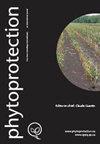Management of Pratylenchus penetrans and Verticilllium symptoms in strawberry
IF 0.2
4区 农林科学
Q4 PLANT SCIENCES
引用次数: 4
Abstract
Under field conditions, the effect of a single rotation with corn, cruciferous crops (canola followed by white mustard) as green manure, oats, and forage pearl millet was measured on the density of Pratylenchus penetrans and its impact on damage and losses caused by Verticillium dahliae in a strawberry plantation the following year. The lowest density of P. penetrans was recorded following forage pearl millet and green cruciferous manure, and in both cases, it was below the known pest threshold in strawberry of 500 P. penetrans kg-1 soil. Both green manure of cruciferous plants and forage pearl millet reduced the incidence of Verticillium wilt and increased the growth of strawberry plants. In the fall, the number of crowns and the number of daughter plants were significantly higher following forage pearl millet or cruciferous plants than corn. The highest wilt symptoms and the lowest strawberry growth were observed in plots previously planted with corn, which also harboured the highest spring populations of P. penetrans. Those results support a positive interaction between P. penetrans and V. dahliae, even more importantly so on susceptible cultivard such as ‘Jewell’.草莓穿透型叶盘虫和黄斑病症状的防治
在大田条件下,以玉米、十字花科作物(油菜先白芥菜)为绿肥、燕麦和饲料珍珠粟,单次轮作,测定了次年草莓园透蚜密度及其对大大花黄萎病危害和损失的影响。在500穿山甲kg-1土壤中,草莓的穿山甲密度均低于已知阈值,最低的是饲料珍珠粟和绿色十字花科肥料。十字花科植物绿肥和饲料珍珠粟均能降低黄萎病的发病率,促进草莓植株的生长。在秋季,采食珍珠粟和十字花科植物后的冠数和子代数显著高于采食玉米。在以前种植过玉米的地块上,观察到枯萎病症状最严重,草莓生长最低,而且这些地块也有最高的春季渗透线虫种群。这些结果支持了穿透性假单胞菌与大丽花之间的正交互作用,甚至更重要的是在“朱厄尔”等易感品种上。
本文章由计算机程序翻译,如有差异,请以英文原文为准。
求助全文
约1分钟内获得全文
求助全文

 求助内容:
求助内容: 应助结果提醒方式:
应助结果提醒方式:


